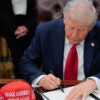Donald Trump and Joe Biden will have to get in line for bragging rights. This fall’s presidential election, the results of which the Trump campaign continues to challenge in key battleground states, is hardly the first national election that went into overtime.
As I examined in my book “Tainted by Suspicion: The Secret Deals and Electoral Chaos of Disputed Presidential Elections,” American history has logged four other times when a presidential election was litigated, through courts or Congress, long after Election Day.
In 2000, Republican George W. Bush and Democrat Al Gore engaged in a 36-day struggle over the election results.
The Daily Signal depends on the support of readers like you. Donate now
That was short compared to 1876, when Republican Rutherford B. Hayes and Democrat Samuel Tilden continued to clash from November to March of 1877 before the election was settled—on the cusp of what was then Inauguration Day for the president.
The 1824 contest, with multiple candidates and one party, came down to John Quincy Adams and Andrew Jackson and it wasn’t decided in the House of Representatives until February 1825.
The situation in 1800 was different, though. Presidential candidate Thomas Jefferson and his vice presidential running mate, Aaron Burr, got the same number of electoral votes for president. The House settled the matter after 36 votes, giving the presidency to Jefferson, and the 12th Amendment to the Constitution later prevented a recurrence.
Here are adapted excerpts from “Tainted by Suspicion” explaining how the other three presidential elections were settled.
1. Adams, Jackson, and ‘Corrupt Bargain’ of 1824
On Dec. 1, 1800, the Electoral College announced the results. Andrew Jackson won the most Electoral College votes, 99, to 84 for John Quincy Adams. However, Jackson didn’t have the majority of electoral votes, then 131, that he needed.
Despite coming in last in the popular vote, William Crawford actually would beat Henry Clay in the Electoral College, 41 votes to Clay’s 37.
Clay, the House speaker, no longer would compete for the presidency in the House of Representatives, because the 12th Amendment states that the House decides only among the top three candidates. Officially, Crawford was in contention in the House, but it was really a contest between Adams and Jackson.
Before the vote, a Philadelphia newspaper, the Columbian Observer, published an anonymous letter Jan. 28 claiming that Clay would back Adams in return for being named secretary of state. Clay strongly denied this.
In fact, two meetings occurred between Adams and Clay, on Jan. 9 and Jan. 29, 1825. Nevertheless, there was not a lot of reason to believe Clay was divided in his loyalty. He and Adams saw eye to eye for the most part on infrastructure, tariffs, and the National Bank.
The House convened Feb. 9, 1825, each state having a single vote that would be determined by a majority vote of its delegation. This time was less dramatic than in 1800. This time it didn’t take 36 ballots, just one. And this time a candidate named Adams prevailed.
Clay directed Kentucky, Missouri, and Ohio—the states he won—to the Adams camp. Most of Clay’s supporters as well as the remaining Federalists backed Adams in the House, enough to give him a single-vote victory.
The House delegations of three states that Jackson carried—Illinois, Louisiana, and Maryland—went to Adams. This gave Adams a majority of 13 out of 24 states.
Though not the first president elected after a drawn-out process, Adams was the only president to assume office without a majority of electoral votes.
In a dour response, Adams said he regretted that there could not be a do-over by submitting the “decision of this momentous question” again, “to obtain a nearer approach to unanimity.”
Adams actually had wanted to name Jackson as secretary of war, but Jackson had other plans for the next four years—running for president.
On Feb. 14, Clay accepted the offer of President-elect Adams to serve as his secretary of state—presumably making him the heir apparent since the last four men to lead the State Department became president. Jackson and his supporters immediately called this a “corrupt bargain” between Adams and Clay.
“The Judas of the West has closed the contract and will receive the thirty pieces of silver. His end will be the same,” Jackson said, referring to Clay.
2. Hayes, Tilden, and the End of Reconstruction
On Jan. 25, 1877, the Senate voted 47-17 to set up an Electoral Commission with five senators, five House members, and five Supreme Court justices to resolve the contest between Rutherford B. Hayes and Samuel Tilden.
Under the proposal, a decision by the bipartisan commission would be final unless it was overridden by both houses of Congress. A day later, the House voted 191-86 to pass the bill, and lame-duck President Ulysses S. Grant signed it Jan. 29.
In a letter to Senate and House leaders asking for leave, the five House members and five senators said the makeup of the commission would be viewed as nearly incorruptible, both in fact and perception.
Some Republicans believed the Reconstruction governments in the Southern states could assure a Hayes victory. Radical Republicans argued intensely that Senate President Pro Tempore Thomas Ferry, R-Mich., had the sole constitutional authority to certify the presidential election and anything short of that would be a cave to the Democrats.
Democrats, for the most part, got what they wanted regarding the process, with a joint session of Congress making the final call.
Supreme Court Justice Nathan Clifford, a Democrat, would serve as chairman of the Electoral Commission. The panel also included Justice David Davis, a Republican but a very independent one.
With 15 members, the Electoral Commission was to have seven Republicans, seven Democrats, and one independent, Davis, who likely would be the tie breaker if things became too partisan.
However, the Illinois state Legislature’s Democratic-Greenback coalition majority voted 101-99 to make Davis the state’s new U.S. senator. Illinois Democrats thought it would sway his vote to Tilden on the commission. But Davis announced that with his resignation from the high court, he could not serve on the commission as the fifth justice.
It was a spectacular backfire by Democrats and a defining moment in the election dispute. Justice Joseph Bradley, a Republican, replaced the independent Davis.
It was the first day of February when the commission convened in the Supreme Court chamber. The Republican lead counsel, William Evarts, argued for allowing only evidence that previously had been submitted to Congress.
Evarts’ argument was largely a practical one—that investigating the Florida vote at the county and local level would drag on and not wrap up in time for inaugurating a new president in March. His opponent in this case, Democratic counsel Charles O’Conor, argued for admitting additional evidence to make the case that Tilden carried Florida.
In what would be a series of party-line votes of 8-7, Bradley tipped the scale to block additional evidence. The next party-line vote was a day later—giving Florida’s four electoral votes to Hayes.
When the Florida vote went to Congress, the Republican-controlled Senate voted to affirm Florida for Hayes and the Democratic-controlled House voted to reject the Electoral Commission’s findings.
Democrats perceived they had a shot in Louisiana. Unofficial returns there gave Democrats a big win, which warranted hearing more evidence. The returning board that certified votes for the state was made up of Republicans.
It was nevertheless as impractical to do a county-by-county canvassing in Louisiana as it would have been in Florida, if a president were to be named by early March.
On mostly technical and practical grounds, the commission cast another 8-7 vote, giving Louisiana to Hayes. South Carolina by this time was almost a formality. Hayes began working on his inaugural address Feb. 17.
The only hope Democrats had was to delay the inevitable decision and threaten chaos after March 4, with no president in office. House Speaker Samuel J. Randall, a Pennsylvania Democrat, led the effort.
In late February, the commission voted 8-7 to award Oregon’s single disputed vote to Hayes. Again, the Republican Senate approved the finding while the Democratic House rejected it. In the midst of the proceedings, the House adopted a resolution declaring that Tilden was the “duly elected president.”
On Feb. 26, 1877, the Electoral Commission heard lawyers’ arguments on South Carolina. That night, four Southern Democrats—Reps. John Y. Brown and Henry Watterson of Kentucky, Sen. J.B. Gordon of Georgia, and Rep. W.M. Levy of Louisiana—met with four Ohio Republicans at the Wormley House hotel in Washington: Reps. James Garfield and Charles Foster, Sen. Stanley Matthews, and Sen.-elect John Sherman.
Their goal: to see if a deal could be reached to prevent House Democrats from blocking the results.
By morning, the lawmakers agreed to stop House Democrats’ delay tactics blocking certification of the Electoral Commission’s findings, on the condition of ending Reconstruction, appointing a Southern Democrat to the Cabinet, and providing federal money for projects in the South.
This was the framework of what would be the Compromise of 1877, which diluted Democratic Party unity.
The next day, the commission—in another 8-7 party line vote—awarded South Carolina’s seven electoral votes to Hayes, which the Senate affirmed and the House rejected one day later.
Congress came into session at 10 a.m. March 1 and went through the night. Democrats kept making motions to further delay with various parliamentary motions to reconsider, to call the roll, to recess—anything to push it a few more days and make Republicans sweat. Randall, the House speaker, even realized by this time it was pointless and refused to entertain any of the mundane motions.
At 4:10 a.m. March 2, the final obstacle to debate was cleared and the joint session declared Hayes the president with the bare minimum of 185 electoral votes to the Democratic ticket’s 184 electoral votes.
3. Bush, Gore, and the Supreme Court
Al Gore’s legal team in Florida, led by former Secretary of State Warren Christopher, requested a hand recount of ballots in the Democratic strongholds of Palm Beach, Miami-Dade, Broward, and Volusia counties.
Local governments in Democratic-run counties were happy to pitch in to produce a Gore presidency.
Gore had 266 electoral votes. George W. Bush had 246. The 20-vote spread in the Electoral College was not that different from the Hayes-Tilden impasse.
On Thursday, Nov. 9, the completed tally showed Bush leading by 1,784 votes out of nearly 6 million votes cast in Florida, narrow enough to trigger an automatic machine recount in all 67 counties under state law.
When the machine recount was completed, Bush’s lead was slashed to just 327 votes over Gore.
Finding more votes for Gore would require hand-counting ballots. This whole ordeal presented a new glossary of terminology such as butterfly ballots and chads (hanging, dimpled pregnant, and other varieties).
Florida’s top election official, Secretary of State Katherine Harris, gave counties until 2 p.m. Nov. 15 to provide reasons why they would need to conduct another recount.
On that day, Harris turned down requests from both Broward and Palm Beach counties to conduct hand recounts.
With the backing of the Gore campaign, the counties took their case to the Florida Supreme Court, where all seven justices were Democratic appointees. The state’s high court sided with the counties and permitted manual recounts in both Palm Beach and Broward to go forward.
Bush’s attorneys appealed to the U.S. Supreme Court, saying Florida’s high court rewrote state election law, usurping the authority of the Florida Legislature to determine presidential electors. That’s because the Constitution granted only state legislatures the right to select electors.
The Bush team also argued that counting select Democratic counties was a violation of the one-man, one-vote principle of the 14th Amendment because the votes in Miami-Dade, Broward, Palm Beach, and Volusia counties would value the votes of those four counties over the missing votes of Florida’s 63 other counties.
The justices agreed to hear Bush’s appeal of the Florida court’s ruling. On Nov. 26, the deadline day, Harris declared Bush to be the winner by 537 votes more than Gore.
As December began, the Bush team argued before the U.S. Supreme Court that the Florida Supreme Court acted improperly. On Dec. 4, the justices ordered Florida’s high court to clarify its ruling on expanding the certification date. In a 5-4 ruling, the justices halted the hand recount pending a hearing.
Gore appealed Dec. 6, asking the Florida Supreme Court for immediate hand recounts in Miami-Dade and Palm Beach counties. On Dec. 8, that court voted 4-3 to order immediate hand recounts of all undervotes, ballots in the state with no presidential vote recorded.
The court in fact gave Gore more than he asked for in a decision that provided him with what probably would be 215 votes in Palm Beach County (the canvassing board found only 174 votes) and another 168 votes in Miami-Dade County.
Further, the court allowed 9,000 votes to be recounted. The majority opinion made no reference to the U.S. Supreme Court’s vacating the earlier ruling. This concerned Gore campaign operative Ron Klain, who feared the U.S. justices would see it as an insult.
The expedited cases of Bush v. Palm Beach County Canvassing Board and Gore v. Harris, both having reached the U.S. Supreme Court, became the case of Bush v. Gore. The lawyers filed briefs Dec. 10 and made oral arguments Dec. 11.
The high court waited until 10 p.m. Dec. 12, two hours before the deadline. The court’s conservative justices, joined by liberals David Souter and Stephen Breyer, sided with Bush in a 7-2 ruling that counting only selected areas of the state violated the Equal Protection Clause of the Constitution’s 14th Amendment.
“Seven Justices of the Court agree that there are constitutional problems with the recount ordered by the Florida Supreme Court that demand a remedy,” the decision reads.
Although seven of the nine justices sided with Bush on the equal protection argument, four liberals insisted that Florida should be given more time to count the votes. That’s where the often-repeated reference to a 5-4 ruling comes from.
This is not to dismiss the secondary ruling. Equal protection was the core of the case, but a 5-4 vote stopped the recount.
Bush won the presidency with 271 electoral votes to Gore’s 266 votes.































